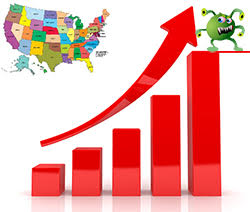Washington, New Hampshire, and Virginia Were the Most Malware Infected States in 2017
 The states of Washington, New Hampshire, and Virginia had the highest malware infection rates in the United States in 2017.
The states of Washington, New Hampshire, and Virginia had the highest malware infection rates in the United States in 2017.
ESG looked at millions of malware infections detected by SpyHunter in each of the 50 states from January through December 2017. ESG then divided the number of infections by each state's population to find an ESG malware infection rate for each state. In 2017, Washington, New Hampshire, and Virginia had the highest infection rates. Wisconsin, Maryland, and Indiana had the lowest. Washington's infection rate was 187% higher than the national average, New Hampshire's what 171% higher, and Virginia's was 87% higher.
"It's hard to know exactly why one state had a higher infection rate than another," said ESG spokesperson Ryan Gerding. "We see states on the east coast and west coast and those with large populations and small at the top and bottom of the list. One reason Washington may be at the top of the list is because Seattle is both a tech hub and home base for Microsoft, there may be a higher percentage of people there who specifically have Windows computers, which is what our software works on."
For the second year in a row, the most common infections detected on computers were adware and PUPs. This infection causes unwanted pop-up advertising to appear on computers, can change browser settings, and make computers run slowly.
Ransomware infections got a lot of attention in 2017. These infections encrypt photos, word documents, and other valuable files on victims' computers, and threaten to destroy them unless a ransom is paid. In 2017, the most common ransomware detected by SpyHunter was CryptoWall Ransomware, which can demand up to $500 in ransom payments.
"Infections like these find their way onto computers in a number of different ways," Gerding said. Sometimes they sneak in as part of freeware that's downloaded from the Internet. Other times, malware makers trick users into clicking on links in fake emails. Regardless of what state you live in, it's important to stay vigilant and protect yourself."
Below is a list of each of the 50 states, along with how much more or less their infection rates were compared to the national average.
Malware Infection Rates During 2017 by State
- Washington 187.21%
- New Hampshire 171.90%
- Virginia 87.46%
- New Jersey 65.99%
- Oregon 37.04%
- Montana 35.60%
- New York 28.99%
- Maine 26.03%
- Wyoming 25.45%
- Arizona 22.50%
- Massachusetts 17.74%
- Arkansas 17.56%
- Georgia 15.59%
- North Dakota 13.97%
- Rhode Island 10.49%
- Vermont 9.88%
- Missouri 8.19%
- Pennsylvania 8.14%
- Nevada 7.27%
- Nebraska 6.18%
- Florida 5.52%
- Iowa 3.53%
- Ohio 3.49%
- Kansas 3.35%
- South Dakota 1.95%
- New Mexico -0.37%
- Idaho -2.69%
- Texas -4.40%
- Illinois -4.59%
- North Carolina -5.33%
- South Carolina -5.61%
- Alaska -7.80%
- Utah -10.00%
- Michigan -13.90%
- Kentucky -17.21%
- Louisiana -18.95%
- Oklahoma -19.64%
- Minnesota -19.77%
- West Virginia -21.79%
- Connecticut -22.06%
- Delaware -27.29%
- California -27.46%
- Hawaii -27.76%
- Tennessee -44.23%
- Alabama -50.93%
- Mississippi -51.65%
- Colorado -59.61%
- Wisconsin -79.66%
- Maryland -81.13%
- Indiana -87.60%
Tips on How to Protect Your Computer
- Regularly backup your data. Ideally, you should have a physical backup (external drive connected to your computer) and a cloud-based backup. Either way, set your computer to back up your files automatically and frequently.
- Set your computer to automatically install any operating system updates that may become available.
- Install a trusted anti-spyware/malware software. We obviously recommend SpyHunter, but whatever software you use, adjust the settings so that updates are installed automatically.
- Be wary of links that are sent to you in emails or social media messages. "Think about that link"